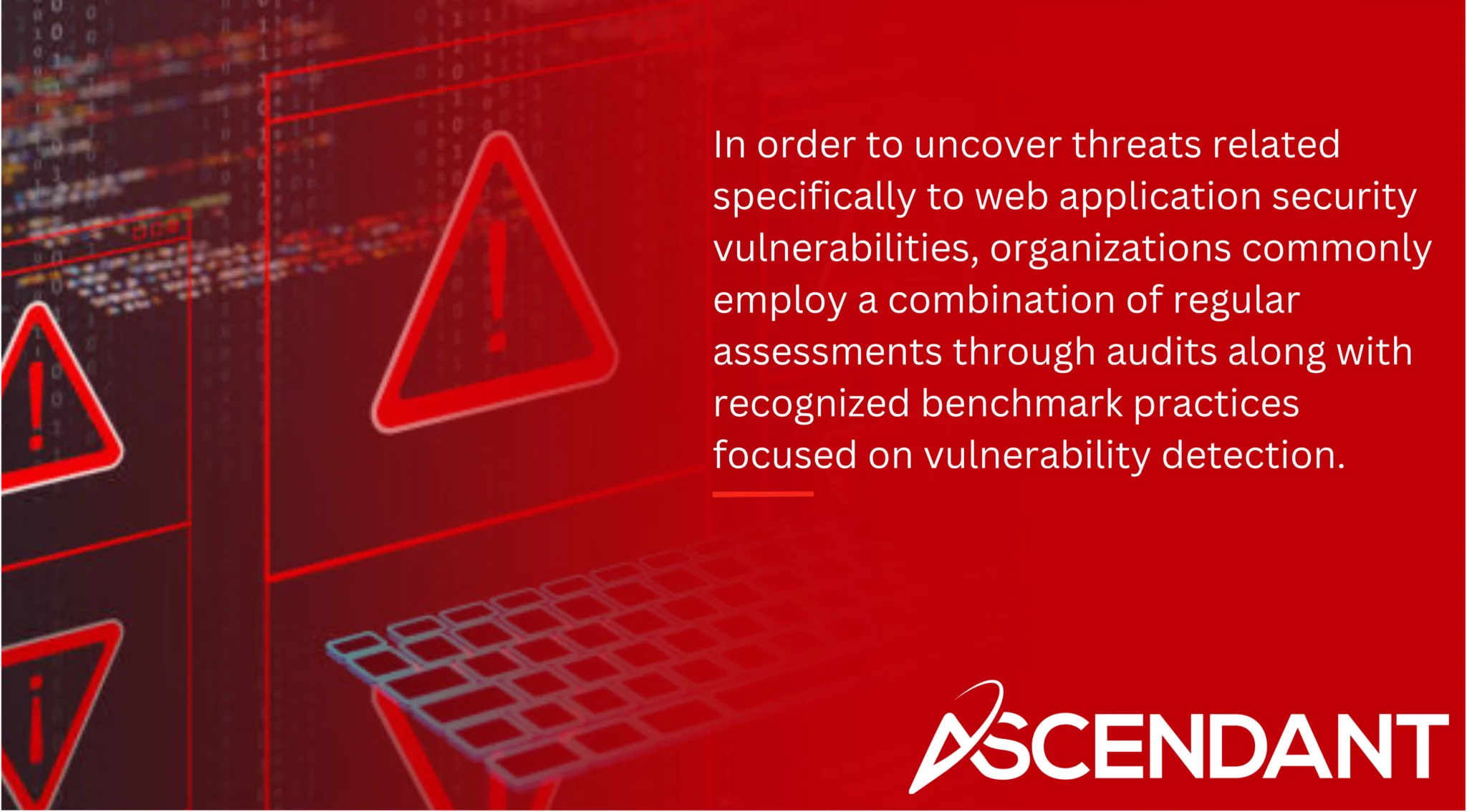Web application vulnerabilities are flaws in web applications that can be exploited to compromise security and data integrity. These vulnerabilities can lead to unauthorized access, stolen information, and disrupted services. Understanding these vulnerabilities and how to guard against them is crucial for ensuring the safety of web applications. This article covers the top 12 web application vulnerability risks and their solutions, helping you protect your digital assets effectively.
Key Takeaways
- Web application vulnerabilities, if overlooked, can lead to serious consequences including financial losses, reputational damage, and legal issues; proactive identification and remediation are essential.
- Common vulnerabilities such as SQL injection, XSS, CSRF, and IDOR require specific preventive measures like input validation, secure coding practices, and unique request tokens to safeguard applications.
- Regular security testing, maintaining updated software, and effective logging and monitoring practices are crucial components in a comprehensive strategy to enhance web application security.
Understanding Web Application Vulnerabilities
Security vulnerabilities in web applications are essentially weaknesses or defects present within the design, deployment, or configuration that can be exploited by attackers. These weak points may allow perpetrators to unlawfully obtain access, acquire confidential data, or interrupt services. Such security breaches pose severe risks for any organization, including financial detriment, harm to their reputation and legal consequences.
Neglecting these security issues within web applications could precipitate dire outcomes. What might begin as minor infringements have the potential to grow into significant incidents of data compromise with substantial ramifications such as eroded consumer trust and expensive remedial actions required. It is essential for entities to give priority attention to identifying and rectifying these flaws in order to preserve the sensitive information of users and uphold system integrity.

In order to uncover threats related specifically to web application security vulnerabilities, organizations commonly employ a combination of regular assessments through audits along with recognized benchmark practices focused on vulnerability detection. Acknowledging prevalent risks enables proactive defense postures against cyber threats while serving as foundational insight critical for constructing solid strategies geared towards maintaining stringent levels of protection across all aspects involving web application securities.
SQL Injection Attacks
SQL injection attacks represent a significant threat to web application security, often stemming from improperly handled user inputs. These types of assaults allow attackers to embed harmful SQL code into queries that the database might execute. If successful, perpetrators could gain unauthorized access and potentially retrieve sensitive data including passwords, credit card numbers, and personal information.
Preventing these attacks effectively requires employing parameterized queries where user-provided input is treated merely as data rather than executable script — this defensive measure assists in blocking insertion of malignant SQL sequences. By only accepting inputs from verified sources and applying stringent filtering techniques can markedly diminish the potential for SQL injection along with other related security weaknesses.
Fortifying web applications against such prevalent threats necessitates rigorous input validation coupled with secure coding protocols. The significance of implementing these defense strategies is critical. Safeguarding web applications hinges on the ability to curtail vulnerabilities like those presented by SQL injection, ensuring their integrity remains uncompromised.
Cross Site Scripting (XSS)
Cross Site Scripting (XSS) is a widespread vulnerability within web applications that permits attackers to inject harmful scripts into web pages. When these scripts execute in a user’s browser, they enable the attacker to alter user information, hijack credentials and even take on the identity of users. The repercussions for both web applications and their users are severe, with potential outcomes including breached accounts and access gained by unauthorized parties to delicate data.
The genesis of XSS vulnerabilities usually stems from inadequate sanitization and validation of user inputs. Web applications that fail to enforce stringent controls over executable content or utilize frameworks that lack security measures open themselves up to attacks via XSS. To counteract these threats, it is vital for data sanitation processes between when data has been inputted and prior to its execution. This helps thwart attempts at injecting malevolent code or scripting.
To effectively shield against XSS assaults:
- Ensuring all input supplied by users conforms strictly with established criteria is an essential measure.
- Disallowing any HTML within submitted inputs and transforming HTML entities into escape sequences can drastically diminish opportunities for exploiting XSS weaknesses.
- Fortifying cookies through setting explicit protocols assists in safeguarding them from being compromised via cross site scripting incursions.
Attending routinely conducted assessments focusing on vulnerabilities or performing penetration testing can unearth not just potential XSS exploits but other pressing security concerns found within web-based apps too.
Cross Site Request Forgery (CSRF)
Cross Site Request Forgery (CSRF) leverages active user sessions to initiate unauthorized actions by impersonating authenticated users. These forms of attacks typically hinge on deceiving the victim into executing unintended activities within a web application. Through exploiting browser mechanics and session cookies, CSRF enables the dispatching of malicious requests without the knowledge or consent of the user.
In order to guard against such site request forgery threats, several strategies should be employed:
- Implement unique tokens in both links and form submissions that verify each request’s authenticity and confirm its origin from an actual user.
- Take advantage of contemporary development frameworks which commonly come equipped with automatic CSRF defense features, making it easier for developers to protect their applications.
- While not foolproof, inspecting referrer headers can offer supplementary support in combatting CSRF exploits although this technique is not immune to circumvention.
Securing web applications against CSRF assaults involves adopting critical measures like incorporating one-of-a-kind verification tokens as well as leveraging built-in mechanisms provided by modern programming frameworks designed for app safety – these are fundamental elements necessary for robust protection against unauthorized requests crafted with malintentions.
Insecure Direct Object References (IDOR)
Web applications can be compromised through a type of vulnerability known as Insecure Direct Object References (IDOR). This occurs when an unauthorized user manipulates input to gain access or modify files and data. By changing URLs or parameters, attackers exploit these vulnerabilities to reach objects they’re not authorized to handle, potentially leading to significant security breaches and unauthorized information disclosure.
To safeguard web applications from such attacks, particularly broken access control scenarios that arise from IDOR vulnerabilities, stringent measures must be in place during all instances where users interact with the application’s features. Ensuring strict verification for each object request is crucial for developers trying to prevent unauthorized usage. The application of meticulous authorization procedures and the use of allowlists are also effective ways to confirm that only permitted users have entry rights over designated objects.
One proactive measure against insecure direct object references is employing intricate identifiers like GUIDs instead of predictable patterns. This helps mask legitimate reference points within the system. Robust controls should accompany these identifiers because without rigorous enforcement alone they offer incomplete protection—especially if exposed via URL manipulation or POST bodies. Following best practices in securing user inputs against tampering ensures heightened defense levels against IDOR threats for any organization’s web infrastructure.
Security Misconfiguration
Security misconfiguration is a widespread vulnerability in web applications. It takes place when the settings of systems or web applications are not properly configured, thus making them susceptible to unauthorized breaches and malicious exploitation.
Instances of such security lapses can be seen through:
- Default configurations that have been left unchanged
- Configurations that haven’t been fully implemented
- Exposing detailed error information as plaintext messages
- Incorrect HTTP header configurations
Attackers often leverage these weak points for easy access into web applications.
One common source for this type of configuration weakness is failing to alter default login details, which effectively lays out a welcome mat for attackers looking to gain entry into the system. Within cloud-based services, instances of security misconfigurations frequently emerge at the forefront due to their potential severe consequences. Ensuring proper setup by enabling secure operations without debugging and maintaining active authentication measures is vital for safeguarding against these vulnerabilities.
To guard against possible oversights leading to security misconfiguration risks, conducting methodical audits and routine scans designed specifically to pinpoint vulnerabilities becomes indispensable. Implementing instantaneous monitoring coupled with alert mechanisms serves as an efficient strategy in early detection of unintended configuration setups or any other abnormal activity signatures within your network infrastructure. Establishing robust user-access policies following least privilege principles aids substantially in reducing exposure arising from configurational mistakes.
Maintaining current safety checks paired with systematic management over application settings plays a pivotal role in defending against novel cyber threats while reinforcing overall integrity across all aspects related directly or indirectly to securing web application functionalities.
Sensitive Data Exposure
The exposure of sensitive data constitutes a severe security vulnerability within web applications, resulting from inadequate encryption when transmitting or housing such critical data. This oversight can make the information easily accessible to individuals without authorization. The fallout from vulnerabilities in sensitive data exposure could be dire, leading to substantial financial loss, erosion of customer confidence, and even legal consequences.

It is vital for organizations to encrypt sensitive information both during storage and transmission to thwart unwarranted access. Encryption should render stored data indecipherable to anyone who lacks proper clearance by scrambling it effectively. Robust management of encryption keys is imperative for maintaining the strength and integrity of this protective measure.
To bolster defenses against uncomplicated decryption attempts, employing advanced algorithms like AES and RSA is advisable. It’s equally prudent not to keep any confidential documents in directories that are directly accessible through a web application. Doing so may open up known security gaps. By embracing these practices diligently, entities can defend their delicate information and preserve its sanctity.
XML External Entities (XXE)
XML External Entities (XXE) vulnerabilities occur when web applications fail to properly configure XML processors, allowing attackers to exploit poor XML parsing. By submitting XML inputs with references to external files or scripts, attackers can gain unauthorized access to sensitive information.
Common types of XXE attacks include External Entity Injection and Parameter Entity Injection, both of which can lead to data exposure or remote code execution. These attacks emphasize the importance of validating and sanitizing XML inputs to prevent the inclusion of external entities.
Disabling external entity processing and using secure XML parsers helps mitigate XXE vulnerabilities. Regular security testing and monitoring can help identify and address potential XXE vulnerabilities in web applications, ensuring that XML inputs are handled securely.
Broken Authentication
Vulnerabilities linked to broken authentication emerge when flawed or ineffective authentication methods are present, providing opportunities for unauthorized parties to penetrate the system and compromise data. The absence of robust controls in identity and access management within web applications can pose considerable security threats. These weaknesses may be exploited by attackers who could then impersonate legitimate users or carry out harmful actions after gaining unauthorized entry.
To bolster web application security, it is advisable to employ Multi-Factor Authentication (MFA), which adds extra layers of verification beyond merely a username and password combination. Leveraging well-established frameworks is another strategy that helps in securing authentication mechanisms and minimizing vulnerability risks. Nevertheless, making session IDs visible within URLs or having inadequate session handling practices leaves room for session fixation exploits as well as unwarranted access incidents.
Applications become more susceptible to attacks if they have suboptimal credential management systems—such as lenient password rules or unencrypted storage of passwords—which simplifies the task for malicious entities seeking entry points into these systems. Stronger password requirements should be mandated along with measures like CAPTCHA that limit repeated sign-in attempts, coupled with effective session control techniques. This array of steps plays an integral part in addressing issues associated with broken authentication vulnerabilities thereby enhancing overall protection levels provided by organizations’ web application infrastructure.
Insufficient Logging and Monitoring
Inadequate logging and surveillance is a significant web application security vulnerability that often results in attackers carrying out their malicious activities undetected, due to poor or non-existent log-keeping practices. Given the dynamic landscape of threat actors and vulnerabilities, it’s imperative for organizations to constantly refine their web application security measures through ongoing monitoring.
By instituting robust logging and oversight protocols, enterprises can gain an upper hand against impending security breaches and weaknesses. It is essential to deploy thorough logging systems that document all vital actions within the system so as to create traceable records which aid in pinpointing the root cause of any issues – be they related to exploitation attempts by adversaries or internal mistakes. Setting up automatic notifications based on key log entries could greatly expedite incident response times.
Preservation of logs plays a pivotal role when addressing cybersecurity incidents. Hence having regular backups made onto distinct servers safeguards against data manipulation or deletion by intruders following an intrusion event. Persistent vigilance through efficient recording and monitoring supports vigorous defense mechanisms for web applications while ensuring readiness against prospective threats.
Using Components with Known Vulnerabilities
Incorporating components that harbor known vulnerabilities can lead to significant security risks for web applications, as malevolent actors may exploit these weaknesses to circumvent protective measures and acquire unauthorized access to sensitive information. Unaddressed vulnerabilities in third-party software can render websites vulnerable, potentially allowing intruders administrative entry.
It is vital for developers of web applications to diligently update and patch their software regularly in order to defend against these recognized security threats. To stay informed about emerging security issues, they should subscribe to the newsletters of products they use and pay attention to related alerts. It is also crucial that developers scrutinize any third-party code with a fine-tooth comb and opt only for libraries well-regarded for their secure features in an effort towards minimizing vulnerability risks.
The employment of open-source codes available publicly poses particular concerns regarding the safety protocols within web applications. Such usage comes with heightened exposure which must be managed cautiously by developers. A meticulous approach involving searching out each component incorporated into the application followed by comprehensive analysis ensures those parts do not inadvertently escalate security perils. By applying these prudent practices effectively, it’s possible not only to curb dangers arising from identifiable vulnerabilities, but also fortify overall defense mechanisms embedded within web application securities systems.
Remote Code Execution (RCE)
Web applications are at risk of Remote Code Execution (RCE) vulnerabilities when they fail to adequately sanitize or validate user inputs, enabling the execution of malicious code from a remote location. RCE issues often stem from coding errors that overlook the verification process for user-provided data, creating substantial security risks.
Attackers frequently exploit known and unpatched vulnerabilities to initiate RCE attacks. Format string assaults can take advantage of special characters in input strings if these inputs aren’t properly checked. Similarly, insecure calls to operating system commands pose a danger as they may allow attackers to inject unchecked inputs into web applications, potentially resulting in exploitation.
To mitigate RCE threats effectively, it is crucial for organizations to enforce stringent validation and sanitization measures on all user inputs. Embracing secure coding practices—including steering clear of unsafe OS command calls and opting for trusted libraries—is integral in safeguarding against potential RCE exploits. Maintaining such high standards in coding helps ensure robust protection against serious instances of RCE within web applications.
Solutions for Securing Web Applications
To ensure the protection of web applications from vulnerabilities, a holistic strategy that encompasses consistent security evaluations and employing vulnerability scanners is necessary. Such scanners are indispensable in spotting potential channels for attacks and weak spots within the software, thus empowering organizations to proactively confront these security risks.
Incorporating continuous security assessments throughout all stages of developing a web application is imperative to manage threats effectively and guarantee solid defense measures. It’s essential to perform checks like vulnerability scans, penetration tests, and source code reviews, which aid in discovering and fixing any prevailing issues with security. Adhering to secure coding practices including proper input validation as well as efficient error management significantly diminishes chances of susceptibility.
Regularly updating software elements with up-to-the-minute patches plays an integral role in preserving the safety of a web application. Keeping track vigilantly for newly detected susceptibilities while swiftly acting on related alerts ensures that one stays ahead against novel hazards threatening their digital resources. By integrating such methods into practice, entities can enhance their stance on securing their online platforms against unwanted intrusions.
Ultimately, tackling prevalent susceptibilities seen across many web applications through preventive actions combined with established guidelines serves as an invaluable cornerstone for maintaining both safety norms pertaining to such virtual services whilst also ensuring they remain robust against possible cyber-attacks—affording organizations confidence that users’ experiences will be secure.
Summary
In essence, vulnerabilities in web applications pose substantial security risks capable of facilitating unauthorized entry and extensive data breaches, among other dire outcomes. Safeguarding sensitive information and upholding the structural integrity of web applications hinges on a thorough comprehension and prompt rectification of such susceptibilities. Tackling various forms like SQL injection attacks to remote code execution demands tailor-made mitigation approaches.
To uphold stringent web application security, it’s imperative for organizations to engage in proactive measures which include consistent security audits, adherence to secure coding practices, as well as comprehensive logging and surveillance mechanisms. These actions enable early detection and correction of potential weak spots before they become targets for malicious exploitation.
The cornerstone for defending web applications is embedded in relentless vigilance coupled with an unwavering commitment to enhance safety measures. Organizations that place high importance on securing their online services through best practice adoption not only safeguard their valuable digital resources but also assure a safe experience for users accessing these platforms.
 Frequently Asked Questions
Frequently Asked Questions
What is a web application vulnerability?
A web application vulnerability is a flaw in the design, implementation, or configuration of a web application that can be exploited, compromising security and data integrity.
Identifying and addressing these vulnerabilities is essential for protecting sensitive information and maintaining user trust.
How can I prevent SQL injection attacks?
It is essential to safeguard against SQL injection attacks by employing parameterized queries, which ensure that user inputs are processed strictly as data and not as executable code.
By adopting such measures rigorously, the security of your application will be significantly improved.
What are the common causes of XSS vulnerabilities?
Inadequate cleansing and confirmation of user inputs, the unchecked execution of scripts, and the use of insecure frameworks often lead to XSS vulnerabilities.
It is essential to tackle these problems in order to protect web applications effectively.
How do I protect against CSRF attacks?
To protect against CSRF attacks, implement unique request tokens in forms and links, utilize built-in CSRF protection features in your frameworks, and verify the referrer header.
These measures will enhance the security of your application effectively.
Why is logging and monitoring important for web security?
Logging and monitoring are crucial for web security as they help organizations detect and respond to security threats while providing a clear record of system activities.
This practice not only identifies vulnerabilities but also strengthens the overall security posture.

